NRSG138: Reflective Essay on Roper Logan Tierney Model of Care
VerifiedAdded on 2023/06/11
|7
|1412
|405
Report
AI Summary
This assignment is a reflective report on the student's learning and understanding of the Roper Logan Tierney (RLT) model of care, the clinical reasoning cycle (CRC), and patient-centered care in nursing. The reflection is based on journal entries from weeks 5, 6, and 7 of the NRSG138 module. The student describes their experiences, feelings, evaluation, and analysis of applying these models to a case study of Jim Laverty, a 65-year-old man who experienced a fall and injury. The student reflects on how these models will inform their future nursing practice, focusing on the importance of holistic assessment, individualized care, and evidence-based practice. The report concludes with an action plan for improving problem-solving and critical thinking skills to better integrate these concepts in clinical practice.
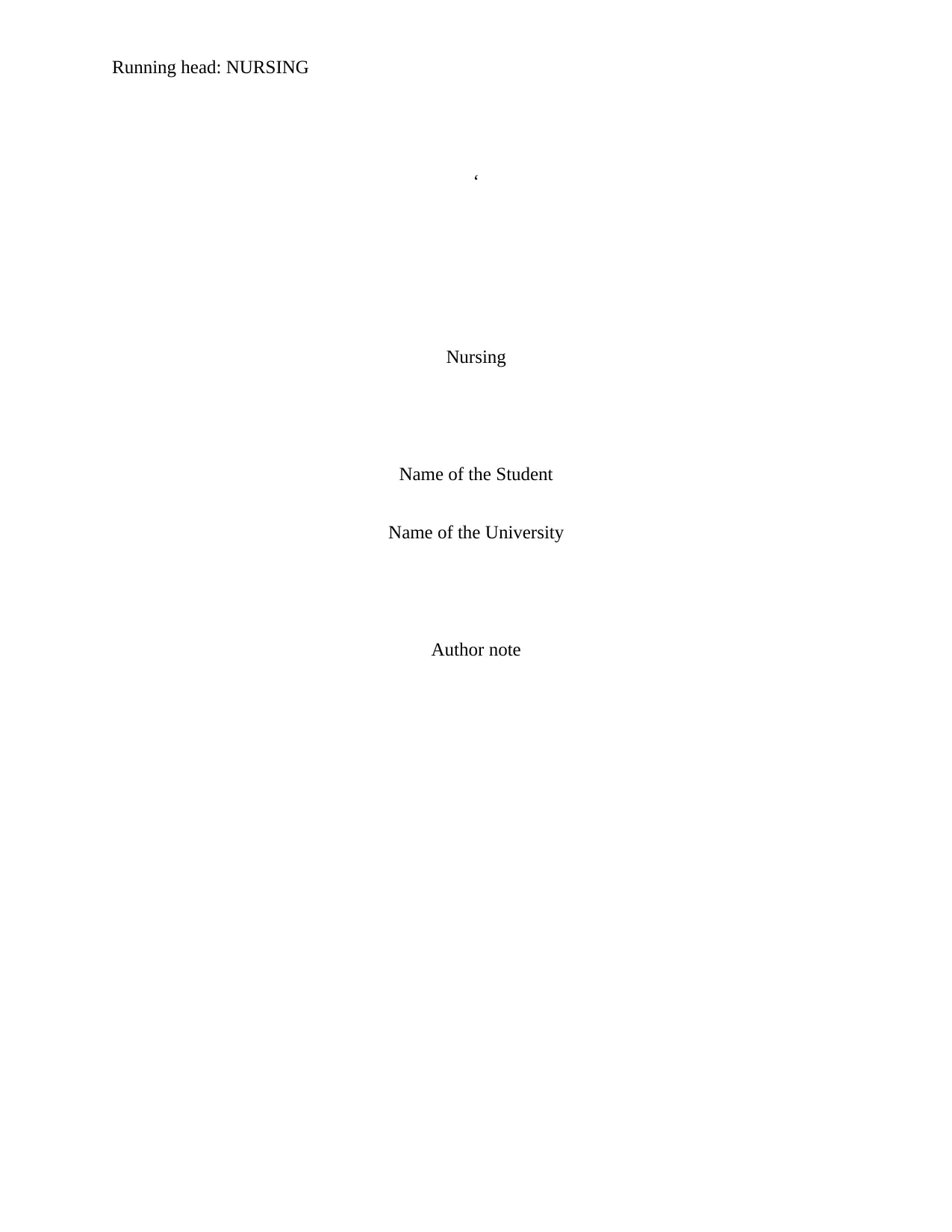
Running head: NURSING
‘
Nursing
Name of the Student
Name of the University
Author note
‘
Nursing
Name of the Student
Name of the University
Author note
Paraphrase This Document
Need a fresh take? Get an instant paraphrase of this document with our AI Paraphraser
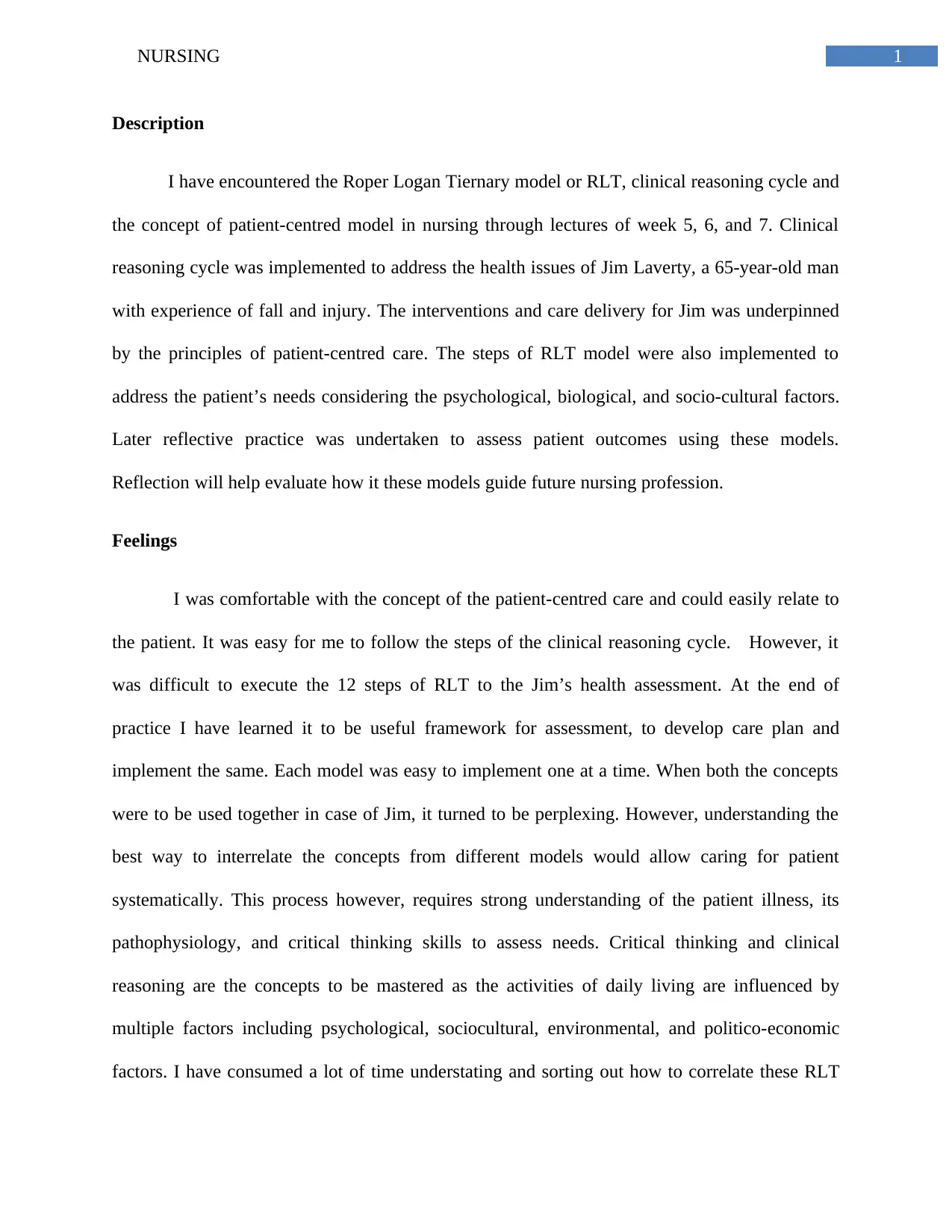
1NURSING
Description
I have encountered the Roper Logan Tiernary model or RLT, clinical reasoning cycle and
the concept of patient-centred model in nursing through lectures of week 5, 6, and 7. Clinical
reasoning cycle was implemented to address the health issues of Jim Laverty, a 65-year-old man
with experience of fall and injury. The interventions and care delivery for Jim was underpinned
by the principles of patient-centred care. The steps of RLT model were also implemented to
address the patient’s needs considering the psychological, biological, and socio-cultural factors.
Later reflective practice was undertaken to assess patient outcomes using these models.
Reflection will help evaluate how it these models guide future nursing profession.
Feelings
I was comfortable with the concept of the patient-centred care and could easily relate to
the patient. It was easy for me to follow the steps of the clinical reasoning cycle. However, it
was difficult to execute the 12 steps of RLT to the Jim’s health assessment. At the end of
practice I have learned it to be useful framework for assessment, to develop care plan and
implement the same. Each model was easy to implement one at a time. When both the concepts
were to be used together in case of Jim, it turned to be perplexing. However, understanding the
best way to interrelate the concepts from different models would allow caring for patient
systematically. This process however, requires strong understanding of the patient illness, its
pathophysiology, and critical thinking skills to assess needs. Critical thinking and clinical
reasoning are the concepts to be mastered as the activities of daily living are influenced by
multiple factors including psychological, sociocultural, environmental, and politico-economic
factors. I have consumed a lot of time understating and sorting out how to correlate these RLT
Description
I have encountered the Roper Logan Tiernary model or RLT, clinical reasoning cycle and
the concept of patient-centred model in nursing through lectures of week 5, 6, and 7. Clinical
reasoning cycle was implemented to address the health issues of Jim Laverty, a 65-year-old man
with experience of fall and injury. The interventions and care delivery for Jim was underpinned
by the principles of patient-centred care. The steps of RLT model were also implemented to
address the patient’s needs considering the psychological, biological, and socio-cultural factors.
Later reflective practice was undertaken to assess patient outcomes using these models.
Reflection will help evaluate how it these models guide future nursing profession.
Feelings
I was comfortable with the concept of the patient-centred care and could easily relate to
the patient. It was easy for me to follow the steps of the clinical reasoning cycle. However, it
was difficult to execute the 12 steps of RLT to the Jim’s health assessment. At the end of
practice I have learned it to be useful framework for assessment, to develop care plan and
implement the same. Each model was easy to implement one at a time. When both the concepts
were to be used together in case of Jim, it turned to be perplexing. However, understanding the
best way to interrelate the concepts from different models would allow caring for patient
systematically. This process however, requires strong understanding of the patient illness, its
pathophysiology, and critical thinking skills to assess needs. Critical thinking and clinical
reasoning are the concepts to be mastered as the activities of daily living are influenced by
multiple factors including psychological, sociocultural, environmental, and politico-economic
factors. I have consumed a lot of time understating and sorting out how to correlate these RLT
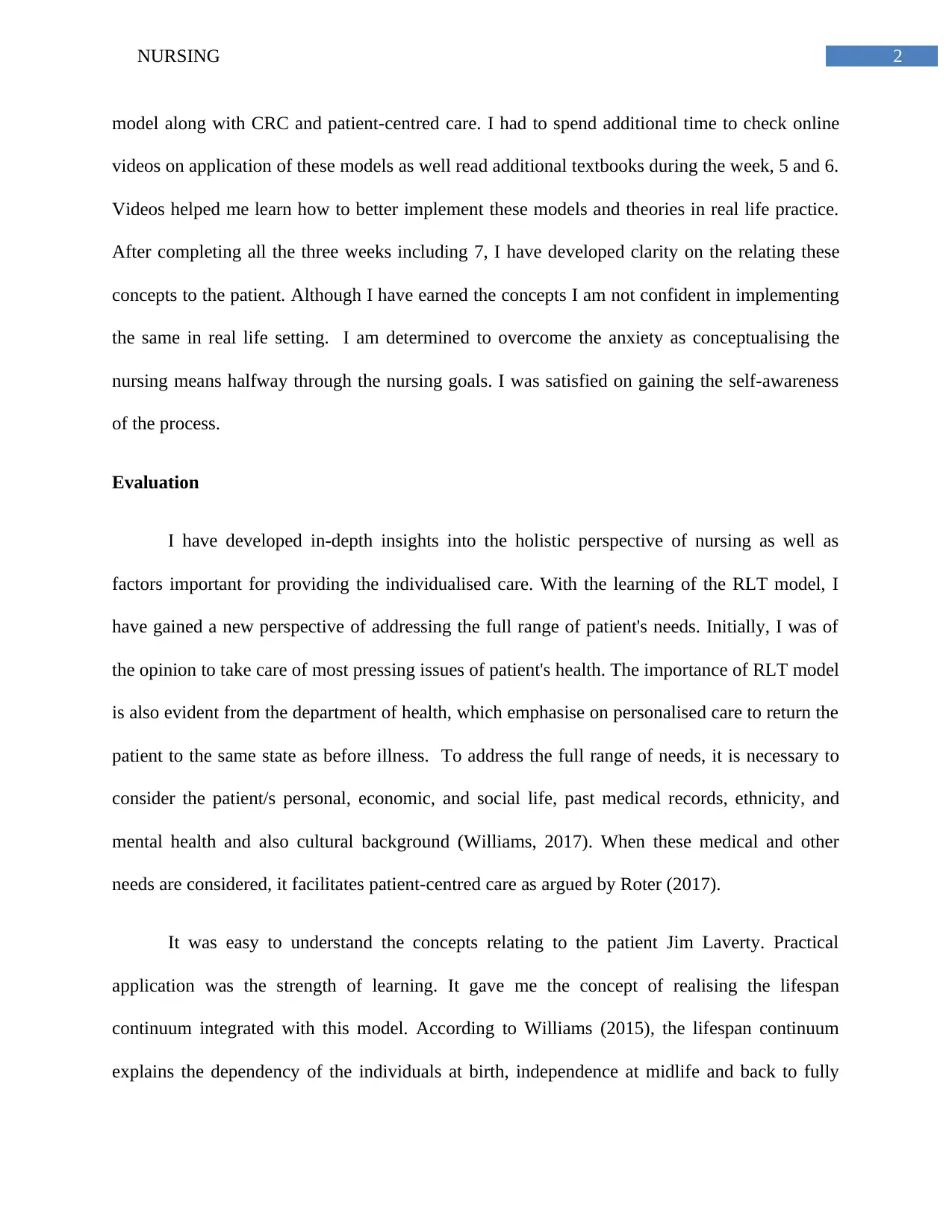
2NURSING
model along with CRC and patient-centred care. I had to spend additional time to check online
videos on application of these models as well read additional textbooks during the week, 5 and 6.
Videos helped me learn how to better implement these models and theories in real life practice.
After completing all the three weeks including 7, I have developed clarity on the relating these
concepts to the patient. Although I have earned the concepts I am not confident in implementing
the same in real life setting. I am determined to overcome the anxiety as conceptualising the
nursing means halfway through the nursing goals. I was satisfied on gaining the self-awareness
of the process.
Evaluation
I have developed in-depth insights into the holistic perspective of nursing as well as
factors important for providing the individualised care. With the learning of the RLT model, I
have gained a new perspective of addressing the full range of patient's needs. Initially, I was of
the opinion to take care of most pressing issues of patient's health. The importance of RLT model
is also evident from the department of health, which emphasise on personalised care to return the
patient to the same state as before illness. To address the full range of needs, it is necessary to
consider the patient/s personal, economic, and social life, past medical records, ethnicity, and
mental health and also cultural background (Williams, 2017). When these medical and other
needs are considered, it facilitates patient-centred care as argued by Roter (2017).
It was easy to understand the concepts relating to the patient Jim Laverty. Practical
application was the strength of learning. It gave me the concept of realising the lifespan
continuum integrated with this model. According to Williams (2015), the lifespan continuum
explains the dependency of the individuals at birth, independence at midlife and back to fully
model along with CRC and patient-centred care. I had to spend additional time to check online
videos on application of these models as well read additional textbooks during the week, 5 and 6.
Videos helped me learn how to better implement these models and theories in real life practice.
After completing all the three weeks including 7, I have developed clarity on the relating these
concepts to the patient. Although I have earned the concepts I am not confident in implementing
the same in real life setting. I am determined to overcome the anxiety as conceptualising the
nursing means halfway through the nursing goals. I was satisfied on gaining the self-awareness
of the process.
Evaluation
I have developed in-depth insights into the holistic perspective of nursing as well as
factors important for providing the individualised care. With the learning of the RLT model, I
have gained a new perspective of addressing the full range of patient's needs. Initially, I was of
the opinion to take care of most pressing issues of patient's health. The importance of RLT model
is also evident from the department of health, which emphasise on personalised care to return the
patient to the same state as before illness. To address the full range of needs, it is necessary to
consider the patient/s personal, economic, and social life, past medical records, ethnicity, and
mental health and also cultural background (Williams, 2017). When these medical and other
needs are considered, it facilitates patient-centred care as argued by Roter (2017).
It was easy to understand the concepts relating to the patient Jim Laverty. Practical
application was the strength of learning. It gave me the concept of realising the lifespan
continuum integrated with this model. According to Williams (2015), the lifespan continuum
explains the dependency of the individuals at birth, independence at midlife and back to fully
⊘ This is a preview!⊘
Do you want full access?
Subscribe today to unlock all pages.

Trusted by 1+ million students worldwide
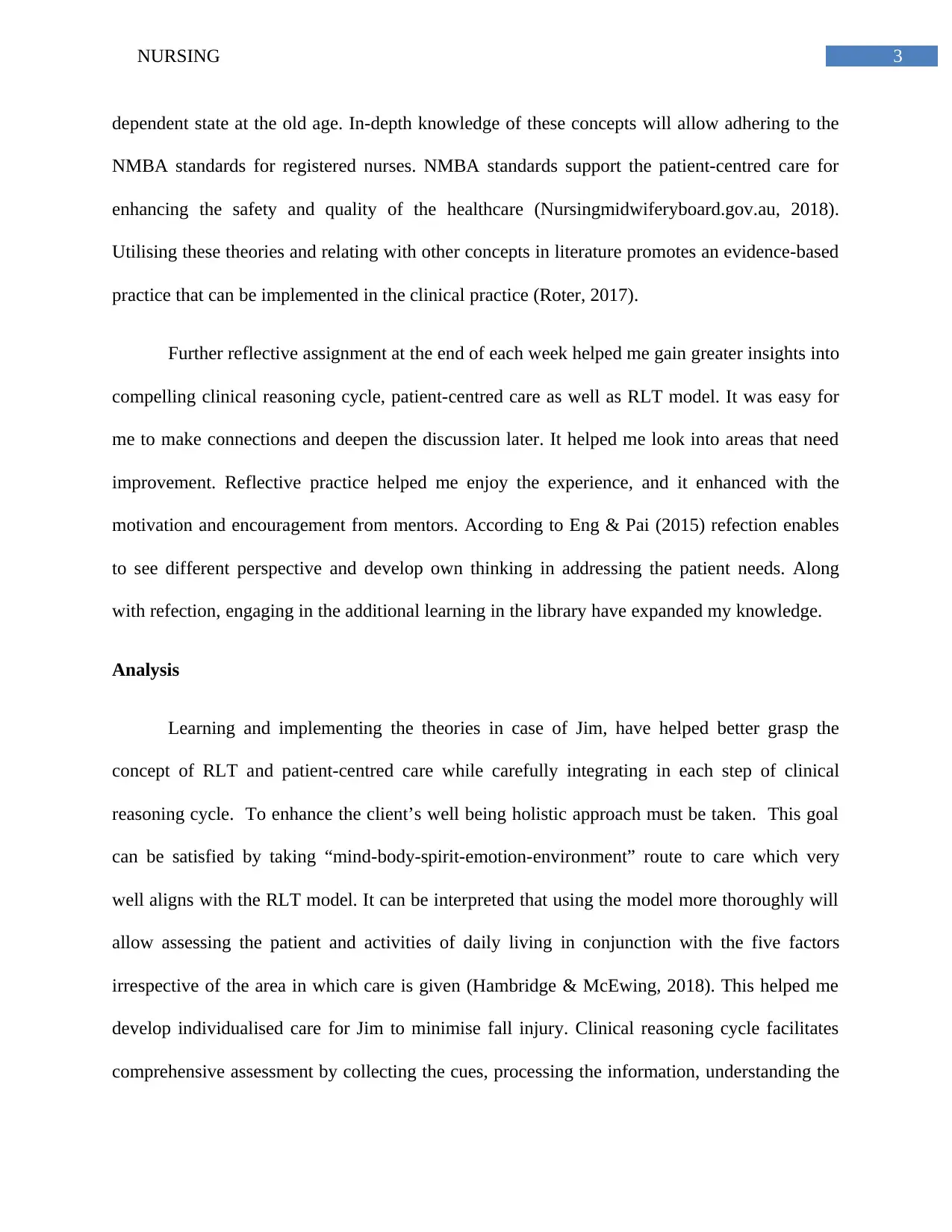
3NURSING
dependent state at the old age. In-depth knowledge of these concepts will allow adhering to the
NMBA standards for registered nurses. NMBA standards support the patient-centred care for
enhancing the safety and quality of the healthcare (Nursingmidwiferyboard.gov.au, 2018).
Utilising these theories and relating with other concepts in literature promotes an evidence-based
practice that can be implemented in the clinical practice (Roter, 2017).
Further reflective assignment at the end of each week helped me gain greater insights into
compelling clinical reasoning cycle, patient-centred care as well as RLT model. It was easy for
me to make connections and deepen the discussion later. It helped me look into areas that need
improvement. Reflective practice helped me enjoy the experience, and it enhanced with the
motivation and encouragement from mentors. According to Eng & Pai (2015) refection enables
to see different perspective and develop own thinking in addressing the patient needs. Along
with refection, engaging in the additional learning in the library have expanded my knowledge.
Analysis
Learning and implementing the theories in case of Jim, have helped better grasp the
concept of RLT and patient-centred care while carefully integrating in each step of clinical
reasoning cycle. To enhance the client’s well being holistic approach must be taken. This goal
can be satisfied by taking “mind-body-spirit-emotion-environment” route to care which very
well aligns with the RLT model. It can be interpreted that using the model more thoroughly will
allow assessing the patient and activities of daily living in conjunction with the five factors
irrespective of the area in which care is given (Hambridge & McEwing, 2018). This helped me
develop individualised care for Jim to minimise fall injury. Clinical reasoning cycle facilitates
comprehensive assessment by collecting the cues, processing the information, understanding the
dependent state at the old age. In-depth knowledge of these concepts will allow adhering to the
NMBA standards for registered nurses. NMBA standards support the patient-centred care for
enhancing the safety and quality of the healthcare (Nursingmidwiferyboard.gov.au, 2018).
Utilising these theories and relating with other concepts in literature promotes an evidence-based
practice that can be implemented in the clinical practice (Roter, 2017).
Further reflective assignment at the end of each week helped me gain greater insights into
compelling clinical reasoning cycle, patient-centred care as well as RLT model. It was easy for
me to make connections and deepen the discussion later. It helped me look into areas that need
improvement. Reflective practice helped me enjoy the experience, and it enhanced with the
motivation and encouragement from mentors. According to Eng & Pai (2015) refection enables
to see different perspective and develop own thinking in addressing the patient needs. Along
with refection, engaging in the additional learning in the library have expanded my knowledge.
Analysis
Learning and implementing the theories in case of Jim, have helped better grasp the
concept of RLT and patient-centred care while carefully integrating in each step of clinical
reasoning cycle. To enhance the client’s well being holistic approach must be taken. This goal
can be satisfied by taking “mind-body-spirit-emotion-environment” route to care which very
well aligns with the RLT model. It can be interpreted that using the model more thoroughly will
allow assessing the patient and activities of daily living in conjunction with the five factors
irrespective of the area in which care is given (Hambridge & McEwing, 2018). This helped me
develop individualised care for Jim to minimise fall injury. Clinical reasoning cycle facilitates
comprehensive assessment by collecting the cues, processing the information, understanding the
Paraphrase This Document
Need a fresh take? Get an instant paraphrase of this document with our AI Paraphraser
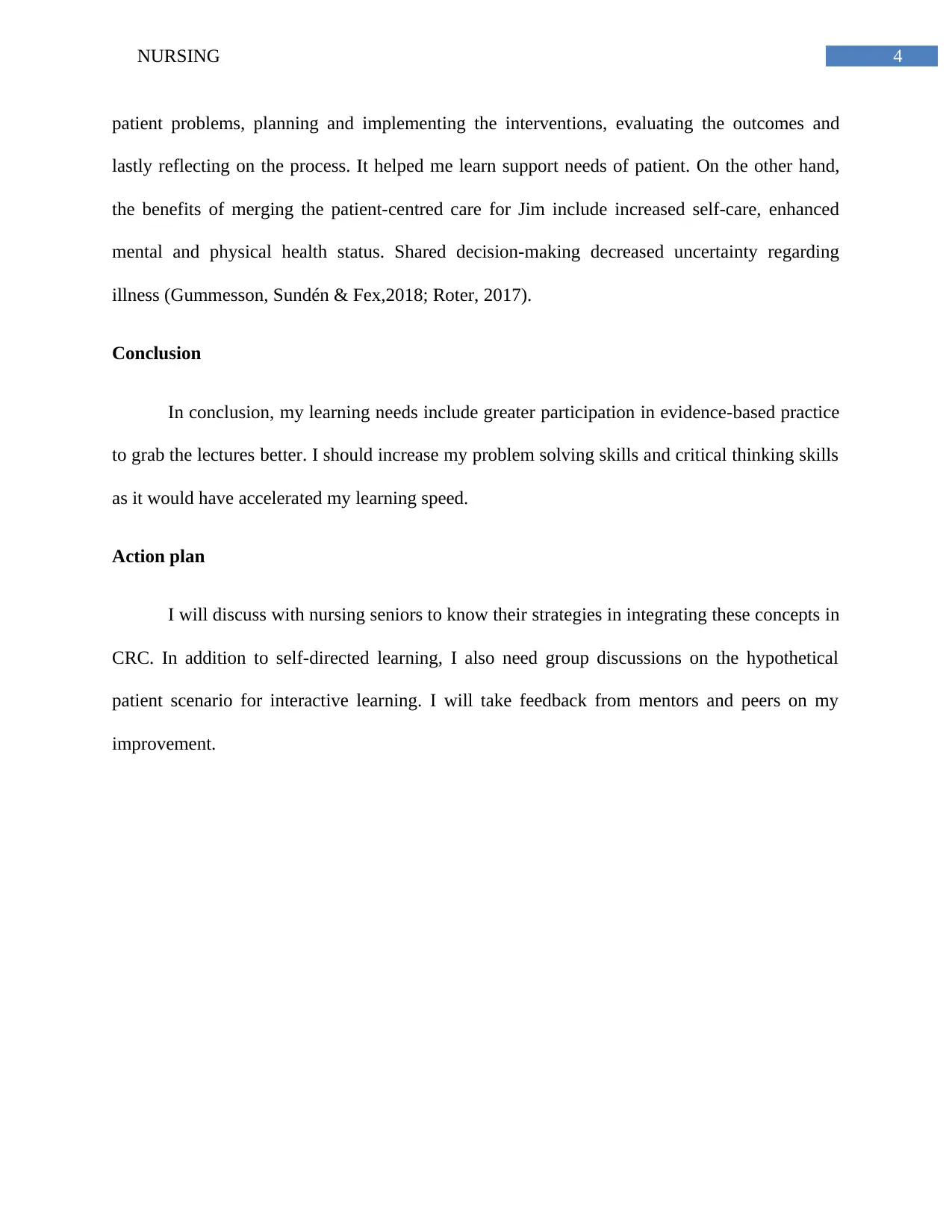
4NURSING
patient problems, planning and implementing the interventions, evaluating the outcomes and
lastly reflecting on the process. It helped me learn support needs of patient. On the other hand,
the benefits of merging the patient-centred care for Jim include increased self-care, enhanced
mental and physical health status. Shared decision-making decreased uncertainty regarding
illness (Gummesson, Sundén & Fex,2018; Roter, 2017).
Conclusion
In conclusion, my learning needs include greater participation in evidence-based practice
to grab the lectures better. I should increase my problem solving skills and critical thinking skills
as it would have accelerated my learning speed.
Action plan
I will discuss with nursing seniors to know their strategies in integrating these concepts in
CRC. In addition to self-directed learning, I also need group discussions on the hypothetical
patient scenario for interactive learning. I will take feedback from mentors and peers on my
improvement.
patient problems, planning and implementing the interventions, evaluating the outcomes and
lastly reflecting on the process. It helped me learn support needs of patient. On the other hand,
the benefits of merging the patient-centred care for Jim include increased self-care, enhanced
mental and physical health status. Shared decision-making decreased uncertainty regarding
illness (Gummesson, Sundén & Fex,2018; Roter, 2017).
Conclusion
In conclusion, my learning needs include greater participation in evidence-based practice
to grab the lectures better. I should increase my problem solving skills and critical thinking skills
as it would have accelerated my learning speed.
Action plan
I will discuss with nursing seniors to know their strategies in integrating these concepts in
CRC. In addition to self-directed learning, I also need group discussions on the hypothetical
patient scenario for interactive learning. I will take feedback from mentors and peers on my
improvement.
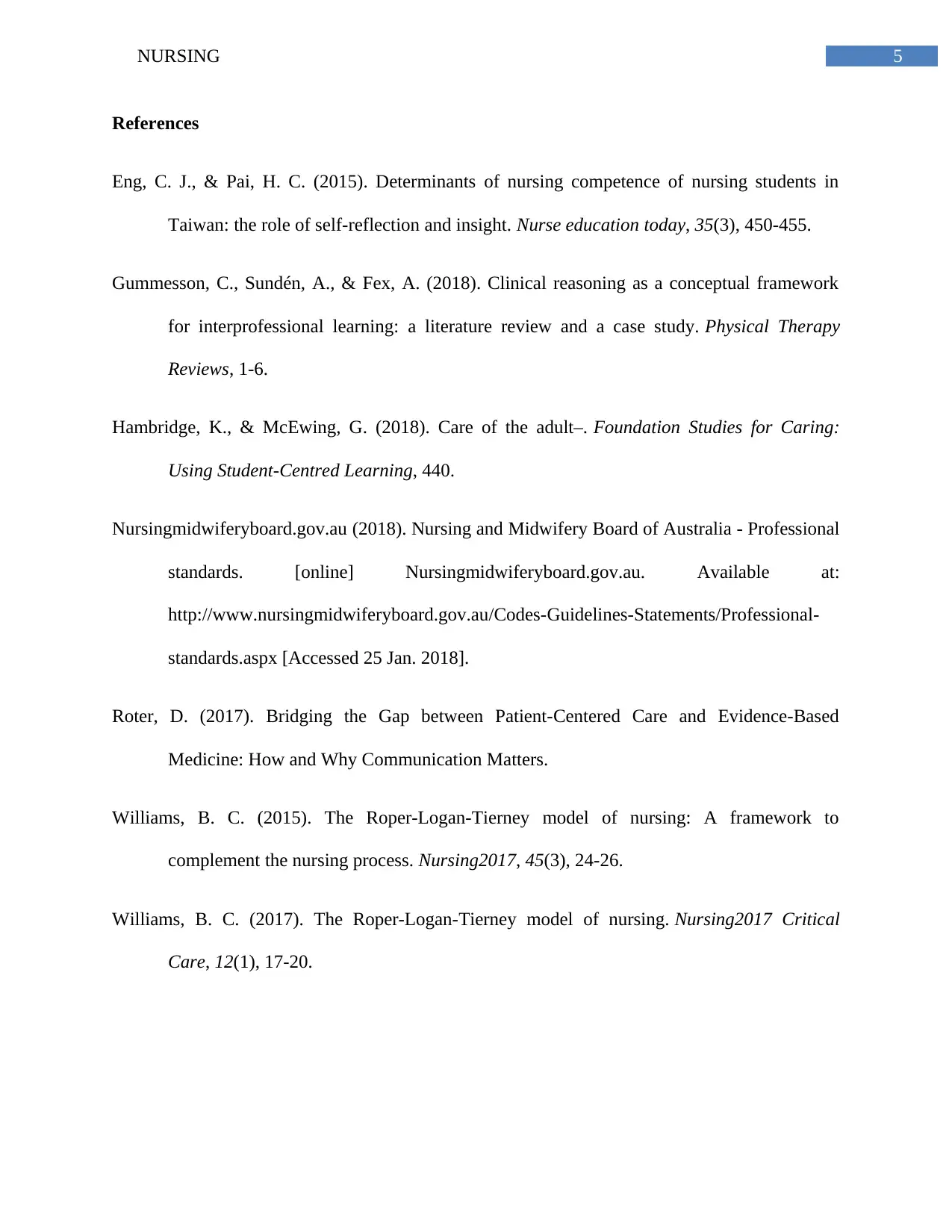
5NURSING
References
Eng, C. J., & Pai, H. C. (2015). Determinants of nursing competence of nursing students in
Taiwan: the role of self-reflection and insight. Nurse education today, 35(3), 450-455.
Gummesson, C., Sundén, A., & Fex, A. (2018). Clinical reasoning as a conceptual framework
for interprofessional learning: a literature review and a case study. Physical Therapy
Reviews, 1-6.
Hambridge, K., & McEwing, G. (2018). Care of the adult–. Foundation Studies for Caring:
Using Student-Centred Learning, 440.
Nursingmidwiferyboard.gov.au (2018). Nursing and Midwifery Board of Australia - Professional
standards. [online] Nursingmidwiferyboard.gov.au. Available at:
http://www.nursingmidwiferyboard.gov.au/Codes-Guidelines-Statements/Professional-
standards.aspx [Accessed 25 Jan. 2018].
Roter, D. (2017). Bridging the Gap between Patient-Centered Care and Evidence-Based
Medicine: How and Why Communication Matters.
Williams, B. C. (2015). The Roper-Logan-Tierney model of nursing: A framework to
complement the nursing process. Nursing2017, 45(3), 24-26.
Williams, B. C. (2017). The Roper-Logan-Tierney model of nursing. Nursing2017 Critical
Care, 12(1), 17-20.
References
Eng, C. J., & Pai, H. C. (2015). Determinants of nursing competence of nursing students in
Taiwan: the role of self-reflection and insight. Nurse education today, 35(3), 450-455.
Gummesson, C., Sundén, A., & Fex, A. (2018). Clinical reasoning as a conceptual framework
for interprofessional learning: a literature review and a case study. Physical Therapy
Reviews, 1-6.
Hambridge, K., & McEwing, G. (2018). Care of the adult–. Foundation Studies for Caring:
Using Student-Centred Learning, 440.
Nursingmidwiferyboard.gov.au (2018). Nursing and Midwifery Board of Australia - Professional
standards. [online] Nursingmidwiferyboard.gov.au. Available at:
http://www.nursingmidwiferyboard.gov.au/Codes-Guidelines-Statements/Professional-
standards.aspx [Accessed 25 Jan. 2018].
Roter, D. (2017). Bridging the Gap between Patient-Centered Care and Evidence-Based
Medicine: How and Why Communication Matters.
Williams, B. C. (2015). The Roper-Logan-Tierney model of nursing: A framework to
complement the nursing process. Nursing2017, 45(3), 24-26.
Williams, B. C. (2017). The Roper-Logan-Tierney model of nursing. Nursing2017 Critical
Care, 12(1), 17-20.
⊘ This is a preview!⊘
Do you want full access?
Subscribe today to unlock all pages.

Trusted by 1+ million students worldwide
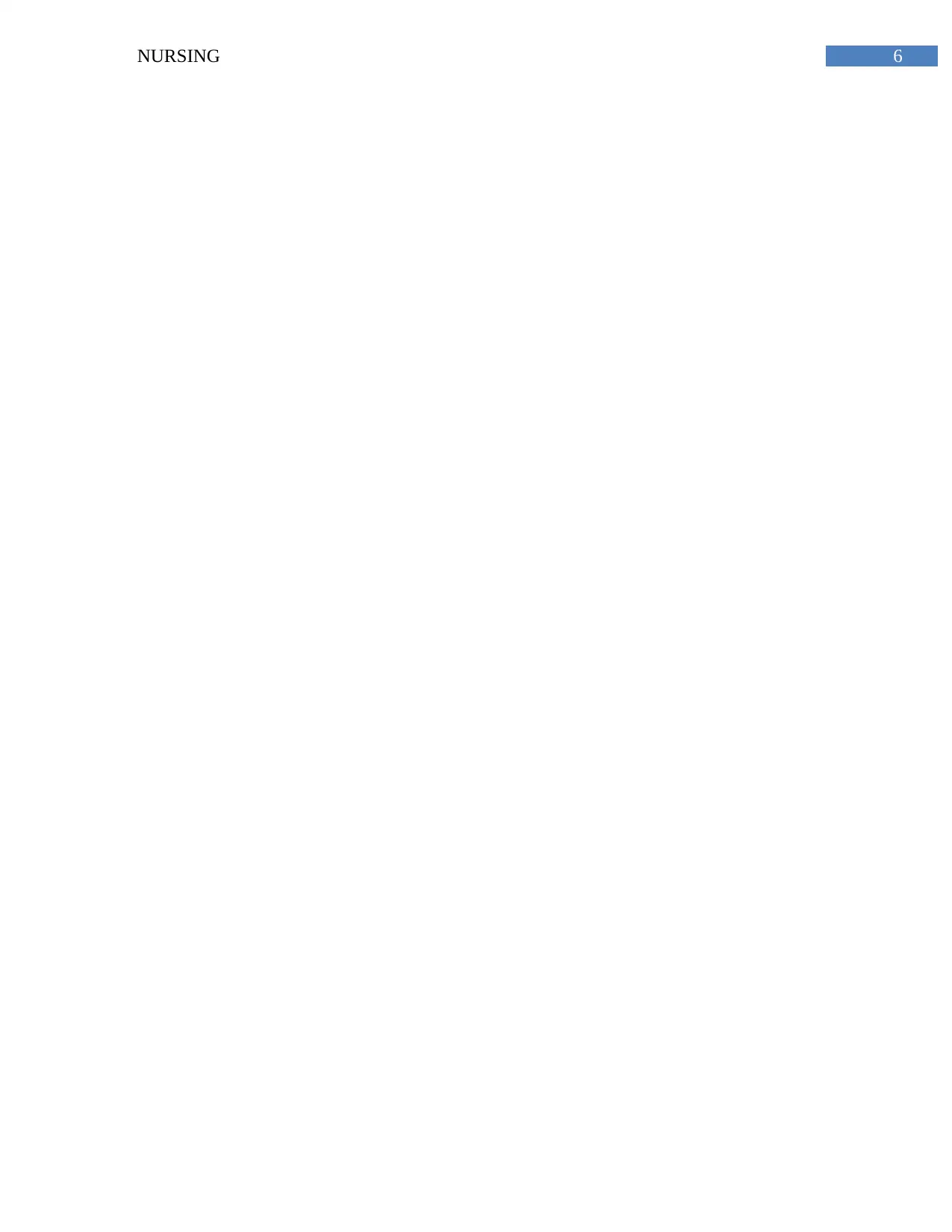
6NURSING
1 out of 7
Related Documents
Your All-in-One AI-Powered Toolkit for Academic Success.
+13062052269
info@desklib.com
Available 24*7 on WhatsApp / Email
![[object Object]](/_next/static/media/star-bottom.7253800d.svg)
Unlock your academic potential
Copyright © 2020–2025 A2Z Services. All Rights Reserved. Developed and managed by ZUCOL.




